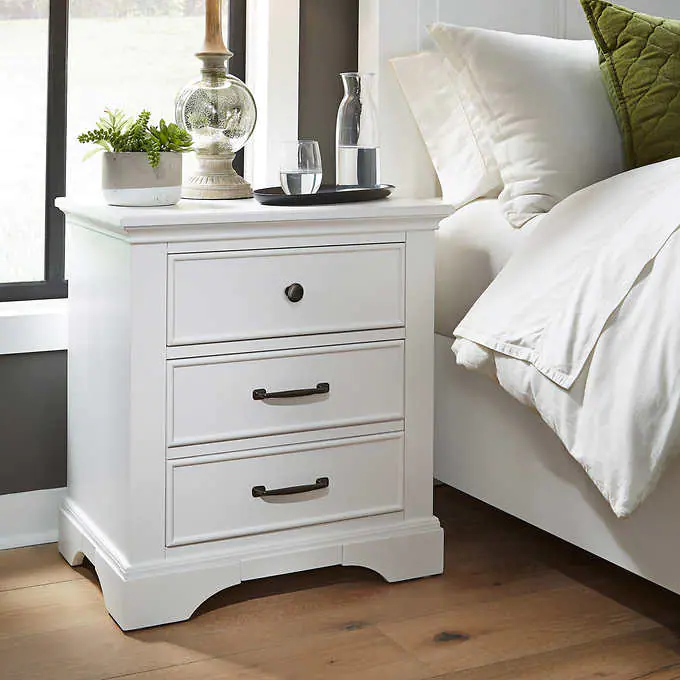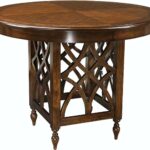As a general rule of thumb, the top of your nightstand should be level with the top of your mattress, or about 2-4″ taller. When a person is lying on the bed, reaching above the bed to grab something is much simpler than reaching below the bed.
Another benefit of a taller nightstand is that you won’t have to stoop down to reach something on it when you’re standing up. The average height of a mattress and foundation is about 25″, so in turn, most commercial nightstands are around 24″-28″ tall.
One shouldn’t have to completely get out of bed or exert much effort to reach any important items you might set on a nightstand, which should also match the decor of the room.
Table of Contents
Three Main Types of Nightstands
Nightstands, as we previously mentioned, come in a wide range of sizes, and if we tried to list every single type of nightstand, we’d be here forever. However, the three most typical types can be summed up as follows.
Bedside Chest
These nightstands are perfect for people who want a little bit more drawer room to store their underwear, socks, and other items., because they come equipped with two or three drawers for storage. A tiny dresser the size of your bedside table comes to mind.
Bedside Cabinets
A bedside cabinet is comparable to a bedside chest in that it has additional storage, but it’s divided between one or two drawers and—you guessed it—a cabinet. This area is useful if you want to keep larger items like an alarm clock out of sight but close to your bed.
Bedside Table
Although some bedside tables may have a small drawer for added storage space, they are more for aesthetics and looks than for practicality. But generally speaking, their primary function is to be attractive and hold small items like a lamp or houseplant.
Take Proper Measurements
Before you start the search for your perfect nightstand (or two if you want a matching set), first you’ll want to measure the height of your mattress on its bed frame. You should keep in mind that your next nightstand should be level or a few inches taller than your mattress. If your bed is resting on a flat platform base, your measurement may come out to be on the lower end around 18″. On the other hand, if you have a canopy bed or an adjustable bed frame, your measurement might come out to be higher — around 36″. As you can see, there is a sizable difference between the two, so you should ensure that your next nightstand corresponds to your mattress in terms of size.
When you’re shopping for a new nightstand, you also want to consider its width, depth, and how its size compares to your mattress. For example, if you sleep on a king or California king mattress, you’ll probably be better off with a larger chest or bedside cabinet to compliment your larger sized bed. Those of you who sleep on a twin mattress, however, might want to pair it with a slim bedside table instead.
You should also be wary of nightstands with a depth larger than 24″ to prevent yourself from bumping into it when you’re hopping in and out of bed. There aren’t many things worse than hitting a solid object with your shin, especially one with a sharp corner.

Considerations When Picking Out a Nightstand
Measure the Height of Your Bed
As previously stated, the general rule is to select a nightstand that is equal to the height of your mattress and bed frame combined. The ideal situation is for your nightstand to be level with the bed, but it’s acceptable if it’s a few inches taller or shorter.
According to Sleep Foundation, the average bed frame is 12 to 16 inches tall, while the standard mattress has a height of 10 to 15 inches. Therefore, depending on the measurements you take, the ideal nightstand height for you could range from 22 to 31 inches, though it’s typically closer to 24 or 25 inches for the typical bed.
Thinner mattresses or mattresses placed directly on the floor without the support of a platform frequently work better with smaller nightstands. However, because contemporary mattresses are taller, a taller nightstand is typically preferred.
Measure Your Height
It’s not necessary for your nightstand to always be level with your mattress. A nightstand that is 2-4 inches taller might be more appropriate for you if you are particularly tall. Generally speaking, you want a nightstand that is taller than your mattress. Reaching up for something is much simpler than reaching down when you’re lying in bed.
Additionally, a taller nightstand that doesn’t require you to stoop down as much is more convenient if you need to pick up something from it while standing. I suggest measuring the length of your arms to get a sense of the ideal nightstand height for you. To ascertain the height you require for your nightstand, try lying in bed or standing up and pretending to pick something up from it.
Storage Space
How important is extra storage space to you? Do you require a few extra drawers to keep papers, your sleep mask, electronic chords, etc.?? In that case, you might want to stick with a chest or cabinet by your bed. The functionality of a table may not match your needs, even though it may look really nice in your bedroom.
Surface Area of Tabletop
We haven’t even discussed the ideal tabletop area of a nightstand in all this discussion about how tall a nightstand should be. Everything really depends on the items you want to keep on your nightstand. Most nightstands should have room for a small lamp and a water bottle if that’s all you keep by your bed. The nightstand you choose should have a top with an appropriate amount of surface area, though, if you’re like me (Slumber Yard member McKenzie) and keep a decorative lamp, an essential oil diffuser, and a wireless phone charger perched on your nightstand.
Style of Nightstand
Choose a nightstand that blends in well with the other pieces of furniture in your room, taking into account the design of your bedroom when deciding on its appearance. A vintage or antique-looking bedside table, for instance, probably wouldn’t fit in your master bedroom’s contemporary design.
Aesthetics
The height of your nightstand should ultimately create a visible impression of scale and aesthetically pleasing aesthetic that will work for you day after day or night after night, as it frequently comes down to your personal preferences and mattress height.
Given that mattress sizes vary greatly depending on customer preferences and sleep requirements, interior designers have no set rules regarding the height of nightstands. Incorporate custom bed frames, and the numbers change. Ultimately the best practices for choosing the right height for your night tables are simple:
- The height of your existing mattress on the bed should be measured.
- Be mindful of the headboard of your bed, any lamp lighting, and how to maintain a clear separation between them.
- Select a nightstand that is 2–6 inches taller, 2–6 inches shorter, or the same height. More might be going too far.
- A nightstand’s appearance and compatibility with your bed can be affected by its style and shape.
- Pick a nightstand from the collection that goes with your bed or coordinates with it.
- Your own sense of style.
There is a nightstand out there for you because there are literally hundreds of them available, both online and offline. It might just require some investigation to locate it.
Measure Headboard and Lamp Height
You probably have a headboard and a lamp in your bedroom, which is like most bedrooms. In light of these considerations, your nightstand’s height is important. To begin with, the scale and height of the headboard should match the height of the nightstand you choose. The aesthetics and unity of the furniture and decor in your bedroom are everything.
Second, if you have bedside lamps, think about their height and how they will appear atop the nightstand. Your nightstand shouldn’t be noticeably taller than your mattress in order for the lamps to be the proper size. The top of the lamp should ideally be somewhere near the top of your headboard. As a result, the lamps are able to illuminate your bed and the entire room effectively.
Take as many measurements as you can to determine the ideal height for your nightstand. You can then determine how everything scales out using this. You should check the headboard height, lamp height, and dimensions in addition to making sure the nightstand is the same height as the top of your mattress.
Read about Average Coffee Table Height
Can You Choose Nightstands That Are Different Heights?
You might occasionally need to buy nightstands of various heights. Your partner’s needs, for instance, might not be the same as yours. Thankfully, sellers of nightstands provide them in heights that typically range from 24 to 30 inches or more.
As a result, you can choose nightstands of various heights based on how comfortably each user will use them. However, if doing so makes the room appear uneven, some people might not like selecting nightstands of different heights.
The Final World
Clearly, not all nightstands are created equal. As a result, when choosing a nightstand, you should take a variety of factors into account in addition to the size and height of your bed.
The nightstand should, in general, be about as tall as your bed. Additionally, the nightstand should be the right size for your bedroom and complement the scale of other bedroom furniture. This means that it should be both comfortable to fit in your bedroom and offer enough surface area for your needs.













